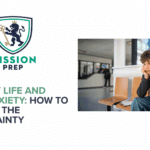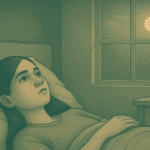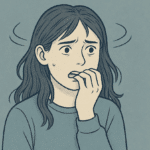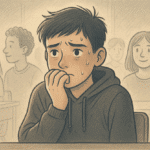Social Anxiety Disorder (Social Phobia) In Teens
Social anxiety can feel like walking through a room full of mirrors where you’re constantly reflecting on yourself, worrying that everyone is watching and judging you.
For many teens, this feeling is more than just being shy or nervous before a big event. It’s a mental health condition called Social Anxiety Disorder (or social phobia), where the fear of being judged, rejected, or embarrassed in social situations becomes overwhelming.
It can make everyday activities like speaking up in class, attending a party, or even hanging out with friends feel like major challenges.
If you’re feeling like this, you’re not alone—and it’s important to recognize the signs and know that help is available. Social anxiety can be tough to deal with, but understanding it is the first step toward feeling better and learning how to manage it.

Signs and Symptoms of Social Anxiety Disorder in Youth
Social anxiety symptoms in teens can sometimes be hard to pinpoint because they might overlap with typical teenage behavior.
Our minds and bodies are deeply connected, which means that social anxiety can manifest in various ways. When symptoms start to impact daily life, it’s crucial to recognize and address them seriously, as they can affect both mental and physical well-being.
Some common signs of Social Anxiety Disorder include physical reactions like sweating, blushing, or trembling when faced with social situations. These feelings aren’t just “butterflies” in the stomach before giving a presentation or going to a party—they can be much more intense, making it hard to even consider taking part in these activities.
Emotionally, you might experience a fear of judgment or constant worry about saying the wrong thing, which can lead to trying to avoid social interactions altogether.
Remember, these symptoms are more than just being a little shy or introverted; they can make everyday interactions feel unmanageable and distressing. Understanding the difference can help you or someone you know recognize when it’s time to seek support.
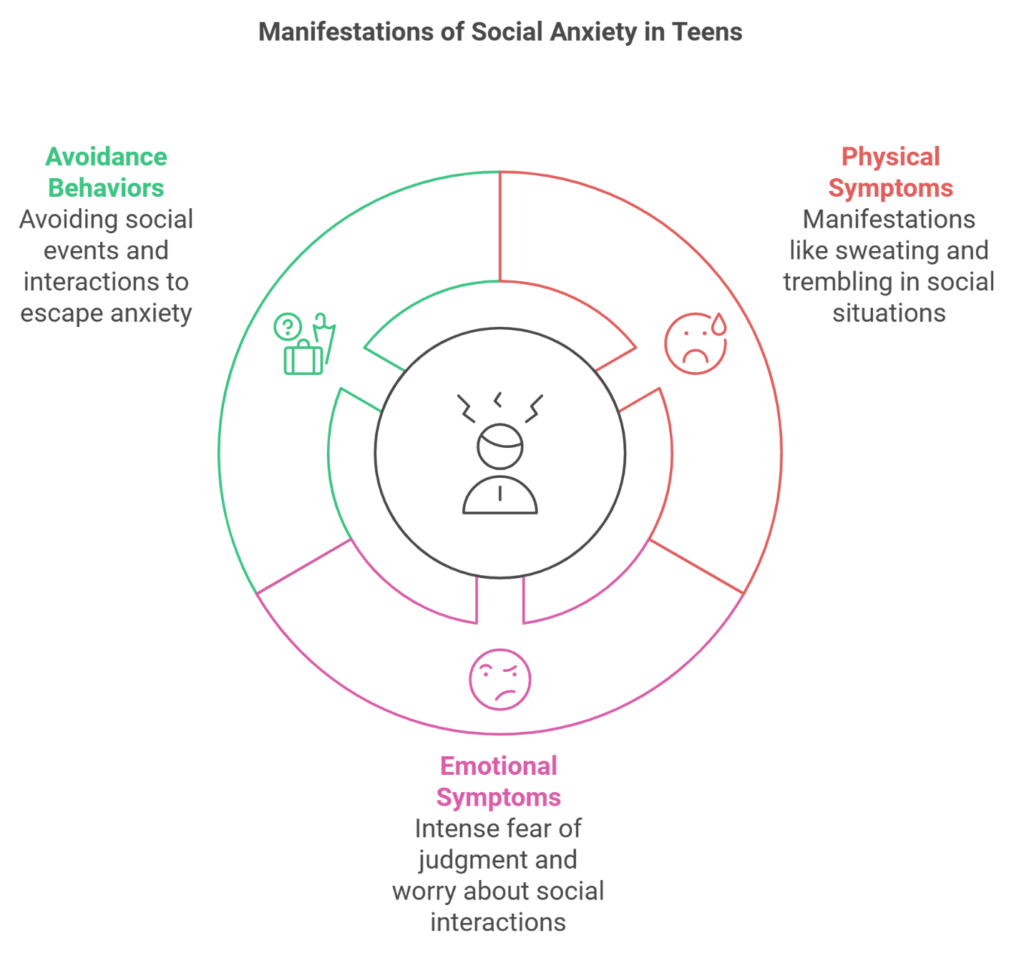
Physical Symptoms of Social Anxiety in Teens
As we discussed, social anxiety can manifest in various physical symptoms that can be especially debilitating for teens trying to enjoy school, events, or social activities.
Some common physical symptoms of social anxiety include:
- A racing heart
- Feeling faint or dizzy
- Gastrointestinal issues like stomachaches or nausea
- Sweating excessively
- Trembling when faced with social situations (such as speaking in class or participating in group projects)
It’s important to recognize that these reactions are not just simple nervousness but can significantly impact a teen’s ability to engage in everyday activities. Being aware of these symptoms can help teens and their parents understand the depth of social anxiety and the importance of addressing it.
Emotional and Behavioral Signs in Teens
The emotional and behavioral symptoms of social anxiety can be equally distressing for teens and can lead to patterns of avoidance.
Emotionally, teens may feel intensely judged, embarrassed, or hyper-aware of their actions in social scenarios. This overwhelming fear of making mistakes or being scrutinized can lead them to withdraw from activities they once loved or steer clear of any new social opportunities.
Behavioral signs might include:
- Avoiding eye contact
- Keeping conversations to a minimum
- Making excuses to avoid social gatherings
Understanding these emotional and behavioral patterns is imperative in identifying social anxiety and helping teens in managing their feelings and interactions more comfortably.
Why Social Anxiety Happens: Causes and Risk Factors for Teens
Understanding the causes of Social Anxiety Disorder in youth can help teens and parents better recognize and manage it. Like most mental health conditions, Social Anxiety Disorder doesn’t have a single cause. Instead, it often results from a mix of biological, environmental, and psychological factors.
These influences can interact in unique ways for each person, but some common risk factors make social anxiety more likely to develop.
Biological Factors
Some people are biologically more likely to develop social anxiety due to genetic links and brain structure. For example, if someone in your family has social anxiety, anxiety disorders, or depression, it might increase your own chances of experiencing social anxiety. Additionally, research shows that certain areas of the brain—especially those that help us manage fear—may be more active in people with social anxiety. These biological factors can create a tendency to feel intense fear in social situations, even if the fear doesn’t always make logical sense.
Environmental Factors
The environmental factors around us—especially the social experiences we go through—can also play a big role in social anxiety. For example, bullying or being made fun of can make someone feel self-conscious or anxious in similar situations later on. Peer pressure to look, act, or perform a certain way can add extra stress, especially for teens who are already feeling unsure of themselves. Even small comments from friends or teachers can make us feel like we’re being watched or judged, which can build up over time and contribute to social anxiety.
Psychological Factors
Psychological factors like personality traits and past experiences can also impact social anxiety. People who are naturally introverted or shy may be more prone to social anxiety because they’re often more focused on their inner thoughts than on socializing. Additionally, past experiences—like a time you felt embarrassed or singled out in front of others—can make you feel anxious in similar situations, even if nothing bad is happening now. These psychological influences can shape how you view yourself and the world, making social situations feel risky or intimidating. Understanding the mix of causes of Social Anxiety Disorder in youth can help teens and parents see that social anxiety isn’t “just nerves.” By recognizing these risk factors of social anxiety, it’s possible to take steps to manage it and find healthy ways to cope.
Diagnosing Social Anxiety Disorder in Teens
Recognizing Social Anxiety Disorder can be challenging because its symptoms are often mistaken for shyness or everyday nerves.
But when social anxiety starts to affect your daily life—like making it hard to attend school, participate in activities, or meet new people—it’s important to consider a real diagnosis. Understanding the process of a Social Anxiety Disorder diagnosis for teens can help you take that first step toward feeling better.
Let’s take a look at how Social Anxiety Disorder is diagnosed:

Self-Assessment Tools for Teens
If you’re wondering whether your social anxiety is more than just occasional worry, a social anxiety self-assessment for teens can be a helpful starting point.
Self-assessment tools, often found online, let you answer questions about common symptoms, such as feeling panicked in social situations, avoiding social activities, or experiencing physical symptoms like sweating or shaking.
These tools aren’t a replacement for a diagnosis, but they can give you a better idea of whether you might need more help. Talking with a trusted adult, like a parent, school counselor, or teacher, can also help you take these initial steps with support.
Getting a Professional Evaluation
For a clear understanding, it’s important to seek out a professional evaluation. Mental health professionals, like counselors, psychologists, or psychiatrists, have experience in conducting social anxiety diagnosis assessments.
During a mental health evaluation for teens, a counselor will usually ask questions about your experiences, feelings, and any symptoms you’ve been dealing with. They might also use specific questionnaires or screening tools to help diagnose social anxiety.
Getting a professional diagnosis doesn’t mean you’ll always feel this way—quite the opposite! Knowing what you’re dealing with makes it easier to get the right support, whether it’s through therapy, skills to handle anxiety, or even connecting with others who understand.
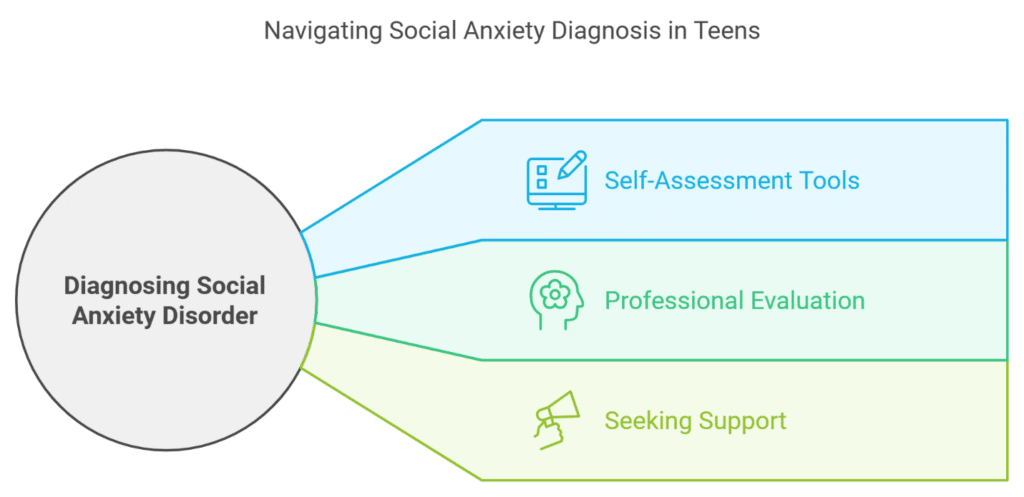
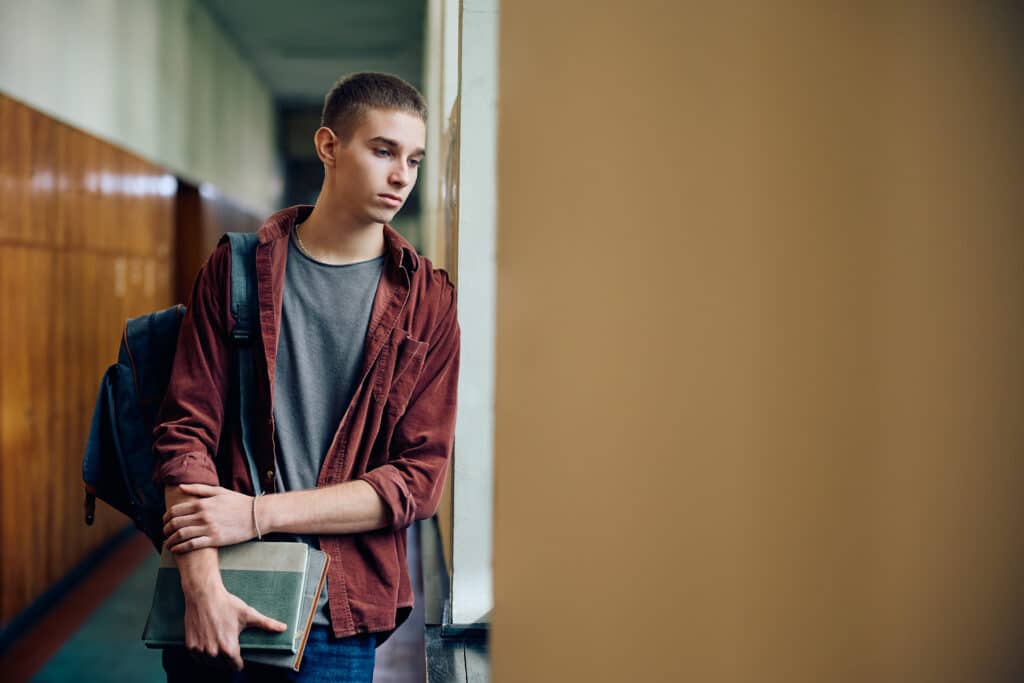
Treatment Options for Social Anxiety Disorder in Youth
When it comes to social anxiety treatment for teens, there are various options to consider, each offering its own set of benefits. Understanding these approaches can make the journey less intimidating and empower you to take charge of your mental health.
Cognitive-Behavioral Therapy (CBT) for Teens
CBT for social anxiety, or cognitive-behavioral therapy for teens, is a popular choice for treating social anxiety. This approach helps you identify and change negative thought patterns around social situations.
For instance, if you typically fear speaking in group settings, CBT encourages you to reframe those thoughts—like replacing “I’ll embarrass myself” with “I can share my ideas and learn from feedback.” Through gradual exposure to social situations and practicing these techniques, you build confidence and find that interactions become less overwhelming over time.
Medication for Teen Social Anxiety
For some, non-medication options might not be enough, and that’s where medication for social anxiety comes in. Anti-anxiety medications, often referred to as anti-anxiety medication for teens, can help balance chemicals in the brain, reducing symptoms of social anxiety.
Common types include SSRIs (Selective Serotonin Reuptake Inhibitors) like sertraline or fluoxetine, and SNRIs (Serotonin-Norepinephrine Reuptake Inhibitors).
While they can be beneficial, it’s important to discuss potential side effects with a healthcare provider. Remember, combining medication alongside therapy often provides the best outcome in managing social anxiety. These options are designed to support teens in finding relief and better handling social situations, making it easier for them to thrive in their everyday environments.
Exposure Therapy:
One effective treatment is exposure therapy for social anxiety, where you gradually face social situations that make you anxious. Instead of avoiding these situations, exposure therapy encourages small steps toward facing them, which can help reduce fear over time.
For instance, if attending social gatherings triggers your anxiety, you might begin by practicing social interactions through role-playing scenarios with a therapist. Next, you could attend a small, supportive group therapy session to engage with others. Over time, this could help you build confidence to participate in larger gatherings.
Exposure therapy works by showing your mind that the fear you feel in these situations doesn’t have to control you. Taking it one step at a time can make a big difference!
Group Therapy for Teens
Group therapy for social anxiety is another helpful option, allowing teens to connect with others who also struggle with mental health.
In group therapy, you’ll be with people your age who also experience social anxiety, so there’s no pressure to pretend you’re not struggling. Sharing your experiences and hearing others talk about theirs can feel incredibly powerful and remind you that you’re not alone.
Often led by a therapist, group therapy sessions include activities and discussions that help build social skills, practice confidence, and develop coping strategies together. Being part of a group that “gets it” can make a world of difference in managing social anxiety.
Self-Help and Lifestyle Changes
Beyond therapy, many teens find self-help for teen social anxiety to be valuable. There are simple, daily lifestyle changes for anxiety that can make social situations feel less overwhelming.
- Mindfulness—focusing on the present moment—can help you feel less anxious about what others might be thinking.
- Journaling is another great tool, allowing you to write down worries, track progress, and even work through challenging situations on paper.
- Confidence-building exercises, like positive self-talk or practicing small social interactions, can also help you feel more comfortable over time.
Small lifestyle changes like these add up, helping you feel more confident and in control, even in stressful social situations.
Coping Strategies for Social Anxiety in Everyday Teen Life
Figuring out how to manage social anxiety can make school and social activities much less intimidating. Having a few practical strategies for coping with social anxiety in specific situations, like classroom presentations or social events, can help you feel more in control and confident.
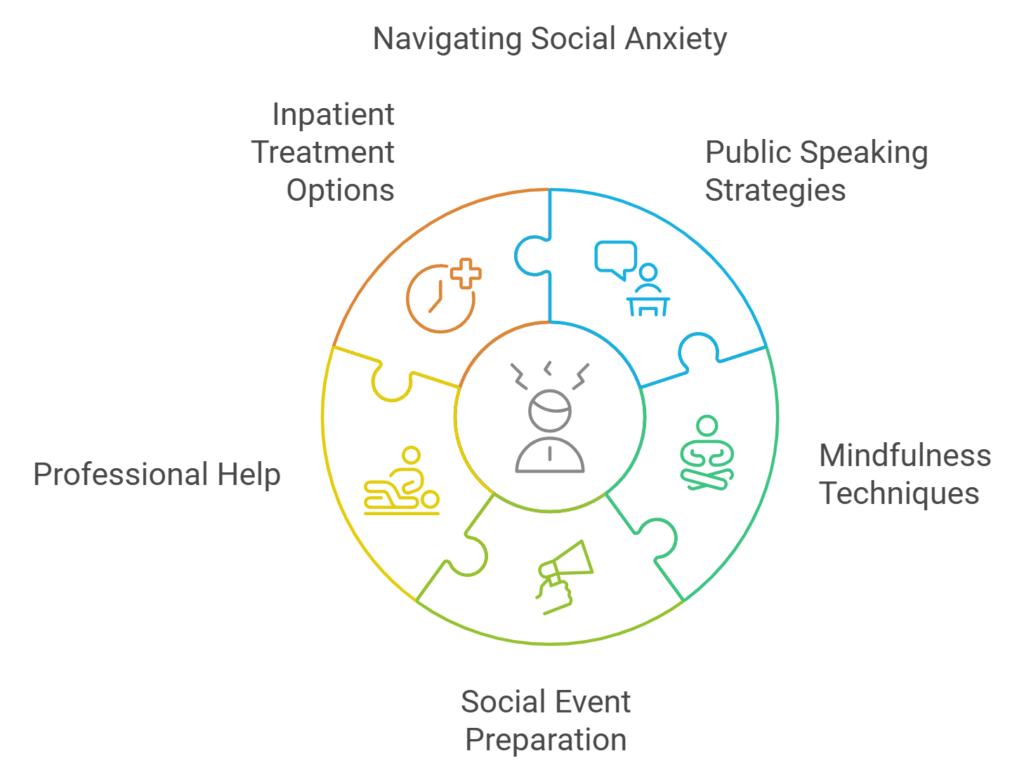
Public Speaking and Social Gatherings
Public speaking with social anxiety can feel like your worst nightmare, but there are ways to make it easier. Start by practicing your presentation in front of a mirror or a trusted friend. Visualizing yourself speaking confidently can help reduce your anxiety. On the day of the presentation, focus on breathing deeply, especially before you begin. You might also find it helpful to have a "safe" person in the audience—someone you can look at if you start feeling nervous. For social gatherings with social anxiety, plan ahead by thinking of a few conversation starters or questions to ask others, like “What do you think of the event?” or “Have you watched any good shows lately?” This can help you feel prepared and ease some of the pressure.
Practicing Mindfulness and Relaxation
Mindfulness for social anxiety is a powerful way to stay calm in the moment. One simple technique is to focus on your breathing: inhale deeply through your nose, hold for a moment, then exhale slowly through your mouth. This kind of relaxation exercise can help you refocus and let go of anxious thoughts. Another quick mindfulness tip is to name five things you can see, four things you can touch, three things you can hear, two things you can smell, and one thing you can taste. This exercise can help ground you in the present moment, especially if you’re feeling overwhelmed. Practicing these techniques regularly can help make them second nature, so they’re ready whenever social anxiety kicks in. With these coping strategies for social anxiety in your toolkit, you’ll feel better prepared to face social situations and manage your anxiety with confidence.
Finding Help and Support for Social Anxiety Disorder
If you’re struggling with social anxiety, there are many options for getting Social Anxiety Disorder help. You don’t have to go through this alone—there are therapists, treatment centers, and online resources that can provide real support.
Reaching out to a mental health professional can be the first step toward feeling better. A therapist who specializes in social anxiety can help you build coping skills, work through fears, and gain confidence. Many people find relief just knowing that there’s a plan for managing their anxiety.

Inpatient and Residential Treatment Options for Teens
For some teens, residential treatment for social anxiety or inpatient treatment for social anxiety in teens can offer the intensive support they need.
These programs provide an immersive environment where you can focus fully on your mental health. Inpatient or residential treatment centers are structured settings, with therapy sessions, activities, and support that are all aimed at helping you manage your social anxiety.
Here, you’ll learn coping strategies, practice facing social situations in safe ways, and get support from professionals who understand what you’re going through. Plus, being around others dealing with similar challenges can make the experience feel less isolating.
When Inpatient Treatment Might Be Needed
Sometimes, more intensive social anxiety treatment centers for teens are recommended if outpatient therapy hasn’t been enough.
If social anxiety is preventing you from attending school, enjoying activities, or feeling comfortable even in familiar settings, residential treatment for severe social anxiety might help. Severe social anxiety can be tough to manage, but these programs are designed to help you tackle it from all angles, with consistent support from trained staff.
Having this type of focused care can make a real difference, helping you take big steps toward managing your anxiety and reclaiming confidence.

